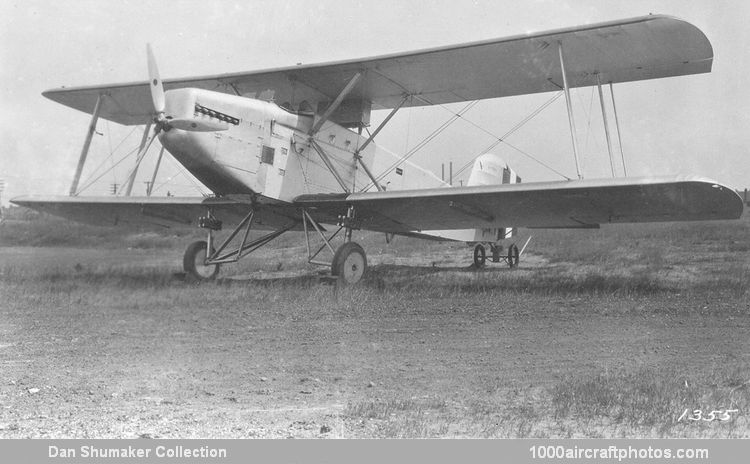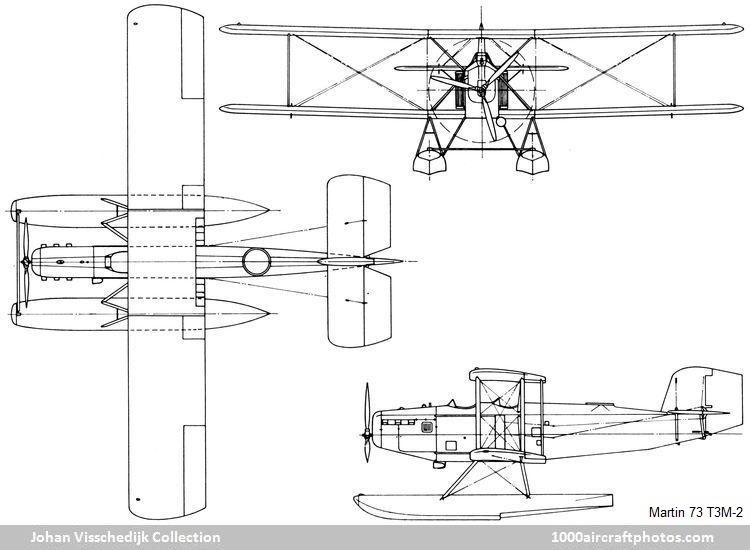08/31/2021. Remarks by Johan Visschedijk: "From its experience in building the Navy-designed SC-1 bomber-torpedo scouts for the USN, the Glenn L. Martin Company at Cleveland, Ohio, was able to offer an improved version (Martin 73) when the Navy needed new aircraft in this category. A contract dated October 12, 1925, was placed for this new version with the designation T3M-1. It differed from the SC-1 in two major respects: the fuselage was a steel-tube structure, and the front cockpit, in which the pilot and bombardier sat side-by-side, was moved forward, ahead of the wing. The gunner's cockpit, fitted with a 0.30 in (7.62 mm) flexible gun, remained unchanged, and a large radiator was slung under the top wing between the cockpits.
In common with its contemporaries, the T3M-1 could operate on wheels or floats. The engine was a 575 hp Wright T-3B twelve-cylinder liquid-cooled V-engine. Deliveries began in September 1926, but comparatively little use was made of the 24 aircraft of this type built (BuNos. A-7065 to A-7088). They were quickly followed by 100 T3M-2s (BuNos. A-7224 to A-7323). Powered by a similar 770 hp Packard 3A-2500, the span of the upper wing was increased to equal that of the lower, and the crew disposition was changed to three in individual cockpits in tandem, with the pilot in the center cockpit and the gunner well back along the fuselage. The Navy ordered 100 T3M-2s, and by mid-1927 this version was serving with VT-1S (USS Lexington) and VT-2B (USS Langley). It quickly became the standard equipment of all Navy torpedo squadrons, whether ship- or shore-based, and it continued to serve with a number of utility units at various shore bases after its retirement from front-line units.
The first T3M-2 (BuNo. A-7224) was re-engined by Martin with a 525 hp Pratt & Whitney R-1690-24 Hornet nine-cylinder air-cooled radial engine as the XT3M-3, and then (modified by the Naval Aircraft Factory) became the XT3M-4 with a similar 525 hp Wright R-1750 Cyclone.
As a result of these experimental installations, the Navy ordered a new prototype (Martin 74) with the Hornet engine, designated the XT4M-1 (BuNo. A-756) and first flown early in April 1927. Apart from the new engine, it had shorter wings and a revised rudder. Like its predecessor, it could operate on floats as well as wheels, but the growing importance of the aircraft carrier during the service lifetime of the T4M-1 meant that most of the 102 built (BuNos. A-7596 to A-7649, A-7852 to A-7899) were operated on wheels with carrier-based squadrons. The first production contract was placed on June 30, 1927, and operational deployment began in August 1928 with deliveries to VT-2B on the Saratoga and VT-1 B on the Lexington, replacing T3M-2s in both these units.
After the Great Lakes Company had acquired Martin's Cleveland factory in October 1928, production was continued under the new company's designation of TG-1, with an R-1690-28 engine and slightly modified landing gear; eighteen were built (BuNos. A-8458 to A-8475).
Detroit Aircraft Corporation received an order for a developed TG-1, designated TE-1, with a 620 hp Wright R-1820-86 Cyclone engine. Subsequently Great Lakes was acquired by Detroit Aircraft and production was transferred to its new subsidiary, redesignated TG-2, 32 aircraft (BuNos. A-8697 to A-8728) were built. The TG-2 outlived the T4M-l in operational use by several years, serving with VT-2 until 1937. Several T4M-1s went to Reserve units in 1932, where the last one remained in use also until 1937.

